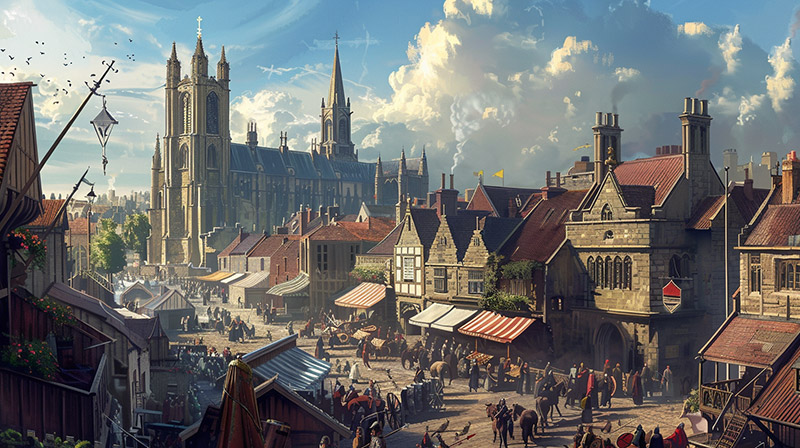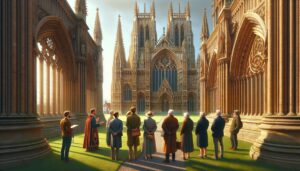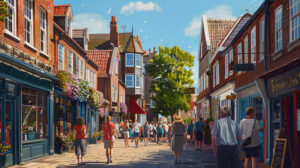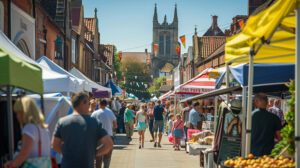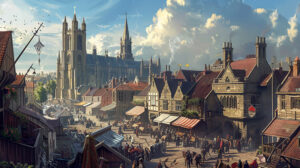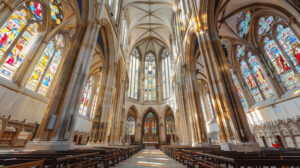Beverley, a picturesque market town in East Yorkshire, boasts a rich and fascinating history that stretches back over a thousand years. Known for its beautiful architecture, historical landmarks, and vibrant culture, Beverley has much to offer those interested in its past. Let’s take a journey through time and discover the captivating history of this charming town.
Early Beginnings and the Founding of Beverley
The origins of Beverley date back to the early 8th century when it was founded by Saint John of Beverley. Born around 640 AD, Saint John was a bishop of Hexham and York who retired to the area now known as Beverley. He established a monastery here, which became a centre of religious activity and learning. The name “Beverley” is believed to be derived from “Beaver-lake,” referring to the beavers that once inhabited the area.
After Saint John’s death in 721 AD, Beverley grew in prominence as a place of pilgrimage due to the miracles associated with his relics. The town’s religious significance attracted many visitors, contributing to its development and prosperity. The original wooden church built by Saint John was a simple structure, but it became a site of great reverence. Pilgrims travelled from far and wide to visit his shrine, seeking blessings and miracles.
The Medieval Period and Beverley Minster
Beverley’s importance continued to grow during the medieval period, particularly with the construction of Beverley Minster. The original wooden church built by Saint John was replaced by a stone structure in the 10th century. However, the Minster as we know it today began construction in the early 13th century and was completed in the 15th century.
Beverley Minster is an architectural masterpiece, renowned for its stunning Gothic design and intricate carvings. It is one of the largest parish churches in the UK and a Grade I listed building. The Minster played a crucial role in Beverley’s religious and social life, serving as a place of worship, pilgrimage, and community gathering. Its twin towers dominate the skyline, and the interior is adorned with beautiful stained glass windows, intricate stonework, and impressive wooden carvings.
The Minster also housed a number of relics and was a centre for learning and music. It had a choir school that trained boys in choral singing, contributing to Beverley’s rich musical heritage. The town itself was laid out with the Minster at its heart, and the streets and buildings that sprang up around it reflect its central role in Beverley’s development.
Beverley’s Market Charter and Economic Growth
In 1129, Beverley was granted a royal charter by King Henry I, officially recognising it as a market town. This charter allowed the town to hold regular markets and fairs, significantly boosting its economy. The Saturday Market and Wednesday Market, established during this period, continue to be vibrant centres of commerce to this day.
The town’s strategic location and thriving markets attracted traders, craftsmen, and merchants, leading to economic growth and urban development. Beverley became known for its wool trade, leather goods, and skilled artisans, contributing to its prosperity throughout the medieval and early modern periods. The markets were bustling hubs where goods from across the region and beyond were bought and sold. Craftsmen set up workshops, and the town’s guilds regulated the quality and standards of the goods produced.
The Tudor and Stuart Eras
The Tudor period brought further changes to Beverley. The Dissolution of the Monasteries under Henry VIII in the 16th century led to the closure of religious houses, including the original Beverley Monastery. Despite these changes, the town continued to thrive economically and culturally. The lands and assets of the monasteries were redistributed, and Beverley adapted to the new social and economic landscape.
During the Stuart era, Beverley’s economy diversified, with the establishment of various industries such as brewing, tanning, and milling. The town’s population grew, and new buildings were constructed, including elegant Georgian houses that still line its streets today. The political and social turmoil of the period, including the English Civil War, saw Beverley involved in significant events. The town was occupied by both Royalist and Parliamentarian forces at different times, reflecting its strategic importance.
The Industrial Revolution and Modernisation
The Industrial Revolution in the 18th and 19th centuries brought significant changes to Beverley. While the town did not industrialise to the same extent as some of its northern neighbours, it still experienced growth and modernisation. New transportation links, such as the Beverley and Barmston Drain and the arrival of the railway in the mid-19th century, improved connectivity and facilitated trade.
Beverley also saw the development of new public buildings and amenities during this period. The Beverley Guildhall, originally built in the 15th century, was remodelled in the 18th century and became the seat of local government. The town’s infrastructure improved, with the introduction of gas lighting, improved sanitation, and public services. The Guildhall, with its beautiful Georgian facade and richly decorated interior, remains a symbol of Beverley’s civic pride.
Beverley in the 20th Century
The 20th century brought further changes and challenges to Beverley. The town played a role in both World Wars, with many residents serving in the armed forces and local industries supporting the war effort. Beverley also faced economic challenges during the interwar and post-war periods, but it continued to adapt and grow. The construction of new housing estates and the expansion of educational and health services marked this period of change.
In the latter half of the century, Beverley embraced its historical heritage and focused on preservation and tourism. Many of the town’s historic buildings were restored, and efforts were made to protect its unique character. Beverley Minster underwent significant restoration work to preserve its architectural splendour for future generations. The development of the Beverley Treasure House, which houses the town’s archives, museum, and art gallery, has further enhanced its cultural offering.
Beverley Today: A Town Steeped in History
Today, Beverley is a thriving market town that seamlessly blends its rich history with modern amenities. Visitors and residents alike can enjoy the town’s beautiful historic sites, vibrant markets, and cultural events. Beverley Minster remains a focal point, attracting thousands of visitors each year who come to admire its Gothic architecture and serene atmosphere.
The town’s historic streets, lined with Georgian and medieval buildings, offer a charming backdrop for shopping, dining, and exploring. The Beverley Guildhall, now a museum, provides insight into the town’s civic history, while the Treasure House and Beverley Art Gallery showcase local art, artefacts, and historical documents.
Beverley’s markets continue to be a central part of town life, offering a wide range of goods from fresh produce to handmade crafts. The Saturday Market and Wednesday Market are bustling hubs where locals and visitors can experience the town’s friendly community spirit. Regular events, such as the Beverley Food Festival and the Beverley Puppet Festival, highlight the town’s vibrant cultural scene and draw visitors from near and far.
Conclusion
Beverley’s rich history, from its founding by Saint John of Beverley to its modern-day charm, makes it a fascinating place to explore. The town’s blend of historical landmarks, vibrant markets, and cultural events create a unique and welcoming atmosphere. Whether you’re a history enthusiast, a casual visitor, or a long-time resident, Beverley’s storied past and lively present offer something for everyone to enjoy. So, take a stroll through its historic streets, visit its iconic Minster, and immerse yourself in the captivating history of Beverley.

